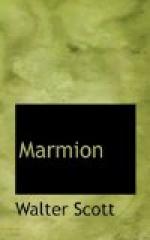The ruin is now carefully protected, visitors being admitted on application at Crichtoun Manse adjoining.
Stanza xi. line 232. ’The castle of Crichton has a dungeon vault, called the Massy More. The epithet, which is not uncommonly applied to the prisons of other old castles in Scotland, is of Saracenic origin. It occurs twice in the “Epistolae Itineriae” of Tollius. “Carcer subterraneus, sive, ut Mauri appellant, MAZMORRA,” p. 147; and again, “Coguntur omnes Captivi sub noctem in ergastula subterranea, quae Turcae Algezerani vocant MAZMORRAS,” p. 243. The same word applies to the dungeons of the ancient Moorish castles in Spain, and serves to show from what nation the Gothic style of castle building was originally derived.’—Scott.
See further, Sir W. Scott’s ‘Provincial Antiquities,’ vol. i.
Stanza xii. line 249. ’He was the second Earl of Bothwell, and fell in the field of Flodden, where, according to an ancient English poet, he distinguished himself by a furious attempt to retrieve the day:—
“Then on the Scottish part,
right proud,
The Earl of Bothwell then out brast,
And stepping forth, with stomach good,
Into the enemies’ throng he thrast;
And Bothwell! Bothwell! cried
bold,
To cause his souldiers to ensue,
But there he caught a wellcome cold,
The Englishmen straight down him threw.
Thus Haburn through his hardy heart
His fatal fine in conflict found,"&c.
Flodden field, a Poem;
edited by H. Weber. Edin.
1808.’—Scott.




